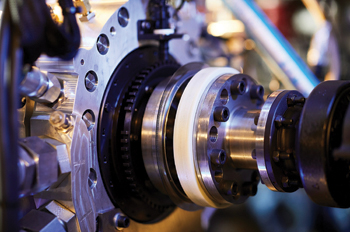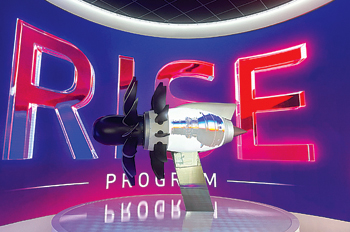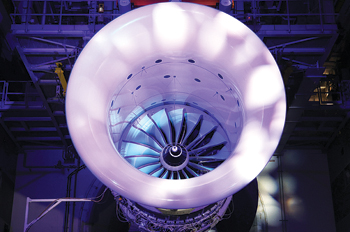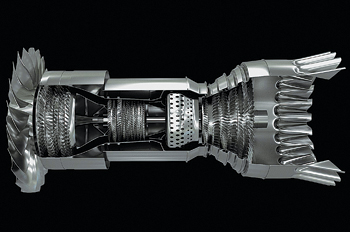INDIAN ARMED FORCES CHIEFS ON
OUR RELENTLESS AND FOCUSED PUBLISHING EFFORTS

SP Guide Publications puts forth a well compiled articulation of issues, pursuits and accomplishments of the Indian Army, over the years

I am confident that SP Guide Publications would continue to inform, inspire and influence.

My compliments to SP Guide Publications for informative and credible reportage on contemporary aerospace issues over the past six decades.
Advancements in Propulsion Technologies
Unveiling the Future of Flight with innovations in Commercial Aircraft Propulsion on showcase at Paris Air Show 2023


(ABOVE) CFM’s revolutionary Innovation for Sustainable Engines (RISE) technology programme.
PRATT & WHITNEY
Raytheon Technologies (RTX) announced significant progress by Pratt & Whitney and Collins Aerospace on advancing hybrid-electric propulsion through the Scalable Turboelectric Powertrain Technology (STEP-Tech) demonstrator, which completed its first engine run and electrical system integration test. As a modular and scalable demonstrator platform, STEP-Tech is intended for rapid prototyping of distributed propulsion concepts applicable to a wide range of next generation applications, including advanced air mobility vehicles, high-speed eVTOL and blended wing body aircraft.
Hybrid-electric propulsion is a key part of RTX’s roadmap for enabling more sustainable aviation, with the potential to enhance efficiency across many future aircraft applications, from advanced air mobility to regional aircraft and single-aisles and the company is leading the development of hybrid-electric technology through multiple demonstration programmes, including STEP-Tech.
RTX is also advancing hybrid-electric propulsion as part of its hybrid-electric flight demonstrator programme, supported by the governments of Canada and Quebec, and the Sustainable Water-Injecting Turbofan Comprising Hybrid-Electrics (SWITCH) consortium, supported by the European Union’s Clean Aviation Joint Undertaking.
These demonstrator programmes are part of a companywide strategy to develop a broad portfolio of sustainable aviation technologies. The strategy recognises the importance of continually advancing aircraft efficiency and enabling wider use of Sustainable Aviation Fuels to support the industry’s goal of achieving net-zero CO2 emissions for civil aviation by 2050.
CFM
Two years after unveiling one of the aviation industry’s most comprehensive technology demonstrator programmes for a more sustainable future of flight, CFM International has completed more than 100 tests as part of its Revolutionary Innovation for Sustainable Engines (RISE) technology programme.
Through the RISE program, CFM is advancing a suite of pioneering technologies, including advanced engine architectures like the open fan, compact core, advanced combustion technology, thermal management, and hybrid electric systems to be compatible with 100 per cent Sustainable Aviation Fuel (SAF). In addition, new technologies are also being matured to test direct hydrogen combustion. The CFM RISE program targets more than 20 per cent better fuel efficiency with 20 per cent lower CO2 emissions compared to the most efficient engines in service today. Technologies are also being validated to meet the most stringent non-CO2 and noise emission requirements.
The innovation at the heart of the RISE program is the openfan architecture, also known as an “unducted fan,” which was first developed by GE and Safran in the 1980s. Open-fan technology derives its name from the absence of a case surrounding the fan. The architecture enables the engine to maintain the speed and performance of traditional turbofans while further increasing fuel efficiency and lowering carbon output. While the single set of variable-pitch fan blades rotate in front, a second set of outlet guide vanes help guide airflow. The result is an open-fan engine with higher fuel efficiency, lower emissions, less noise, and turbofan flight speeds.
In addition to the open-fan design and carbon-fiber composite fan blades, the CFM RISE team is improving the core of the engine, the section that holds the compressor, combustor, turbine, and other components that convert the fuel’s energy into efficient rotary motion. To do this, they’re using a groundbreaking material that has been tested inside both the CFM LEAP and GE9X engines: ceramic matrix composites. These parts, which are lighter, stronger, and more heat-resistant and damage-tolerant than traditionally manufactured metal parts, helped make the LEAP engine 15 per cent more fuel-efficient than its predecessors.
CFM International is also redesigning some parts of its LEAP engine to improve durability in harsh climates, to be available for retrofit on Airbus and Boeing jets next year. The move is CFM’s response to the analysis of high-pressure turbine blades and turbine nozzles when operating in harsh and hot environments. CFM said measures to improve durability in hot and dusty climates would also extend the time on wing in normal ones.
ROLLS-ROYCE
Rolls-Royce has successfully completed the first tests of its UltraFan technology demonstrator. The first tests were conducted using 100 per cent Sustainable Aviation Fuel (SAF). Confirming the capability of the suite of technologies incorporated in the demonstrator is a big step towards improving the efficiency of current and future aero-engines. UltraFan delivers a 10 per cent efficiency improvement over the Trent XWB, which is already the world’s most efficient large aero engine in service. In the nearer term, there are options to transfer technologies from the UltraFan development programme to current Trent engines, providing our customers with even greater availability, reliability and efficiency. In the longer term, UltraFan’s scalable technology from ~25,000-110,000lb thrust offers the potential to power new narrowbody and widebody aircraft anticipated in the 2030s.


Rolls-Royce also announced its new small gas turbine that has been specifically developed to power hybrid-electric flight is set to begin testing. The engine is part of a turbogenerator system that is being developed for the Advanced Air Mobility market. This includes electrical vertical take-off and landing (eVTOL) Aircraft for Urban Air Mobility and Commuter Aircraft applications up to 19 seats. The turbogenerator system will complement the Rolls-Royce Electrical propulsion portfolio by delivering an on-board power source with scalable power offerings between 500kW and 1200kW enabling extended range on sustainable aviation fuels (SAF) and later, as it becomes available, through hydrogen combustion.
This will open up new, longer routes than electric battery powered aircraft can support as of today. The development of the turbogenerator system is combining Rolls-Royce’s electrical and gas turbine development competencies. The new combustion engine uses recent technology developments to achieve a step change in efficiency of small gas turbines. The turbogenerator can be used in serial or parallel hybrid applications. It is well suited to recharge batteries as well as provide energy to electrical propulsion units directly and therefore enables aircraft to switch between power sources in flight.
BOOM SYMPHONY
Boom Announced Significant Overture Program Advances at Paris Air Show including milestones for its Symphony engine. Symphony, Overture’s propulsion system, is optimised for 100 per cent sustainable aviation fuel (SAF).
Boom shared the engine architecture for Symphony and additional key specifications, and also unveiled a 3D-printed 1/3 scale design model. The engine’s bespoke design is optimised for sustainable supersonic flight and is designed to deliver 25 per cent more time on wing and provide 10 per cent operating cost savings to airline customers. This marks an important step in Symphony’s development since its announcement in December 2022.
Symphony Technical Specifications
- Two-spool, medium-bypass turbofan engine, no afterburner
- 35,000 lb thrust
- Optimised for 100 per cent sustainable aviation fuel (SAF)
- Single-stage 72” fan
- Air-cooled cooled, multi-stage turbine
- Additive manufacturing enables lightweight, low part count, and reduced assembly costs.





